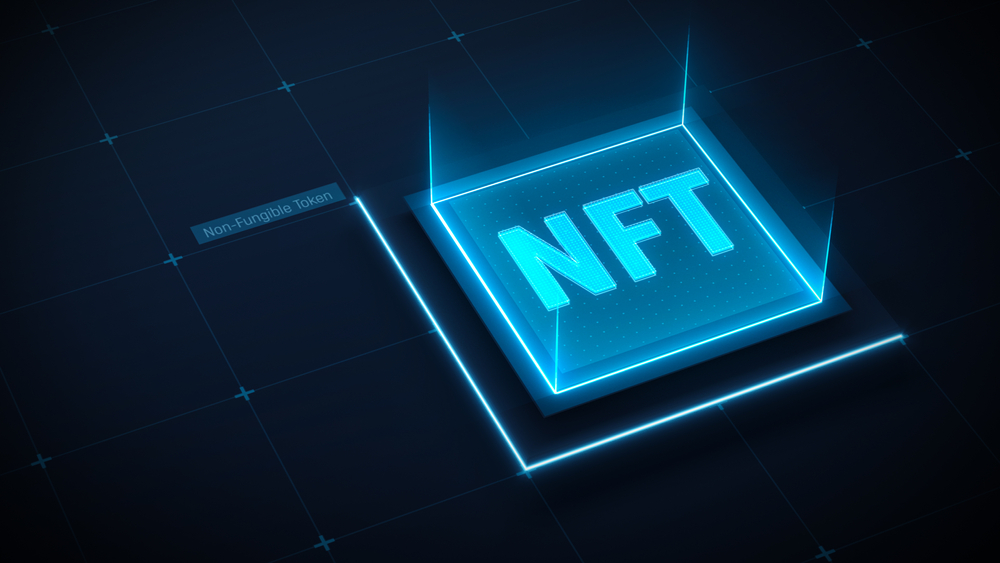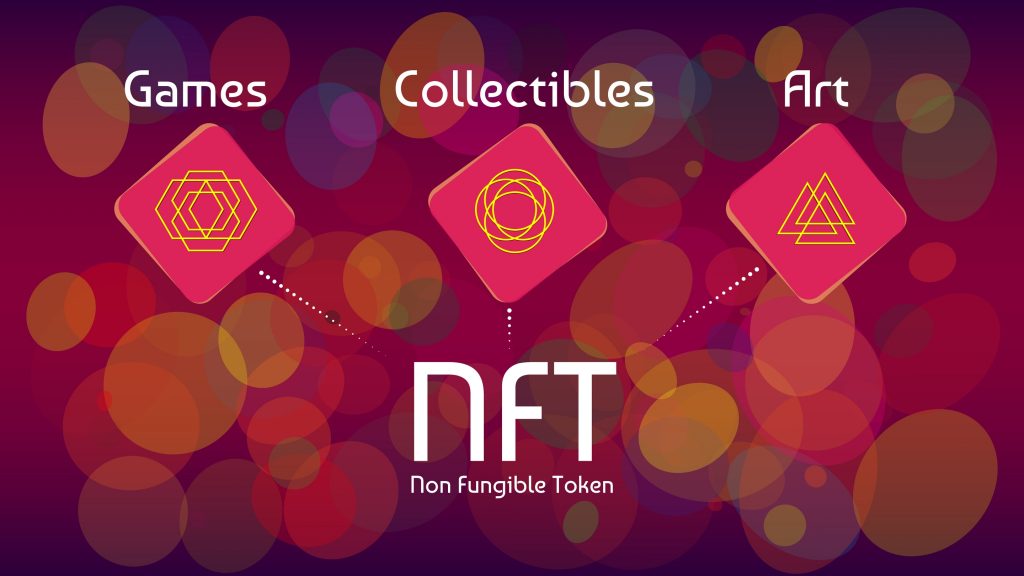
All the hype about NFTs has got you thinking What’s up with that? The truth is, non-fungible tokens — shortened to NFTs — are shaking up the world of art and finance. But what are NFTs, how do they work, and — here’s the million-dollar question — how do you to make money off NFTs?
In this article, we seek to answer those questions and a lot more. NFTs aren’t just for high-end art dealers or the heavy-hitters of Silicon Valley. You, too, can not only understand how to make money from NFT, but you can also take advantage of this revolutionary use of blockchain technology. Let’s get started.
But before we answer what we all want to know: how to make money off NFTs, let’s first define — in simple terms — what an NFT even is. And what is the NFT market like?
What are NFTs and What Are They Used For?
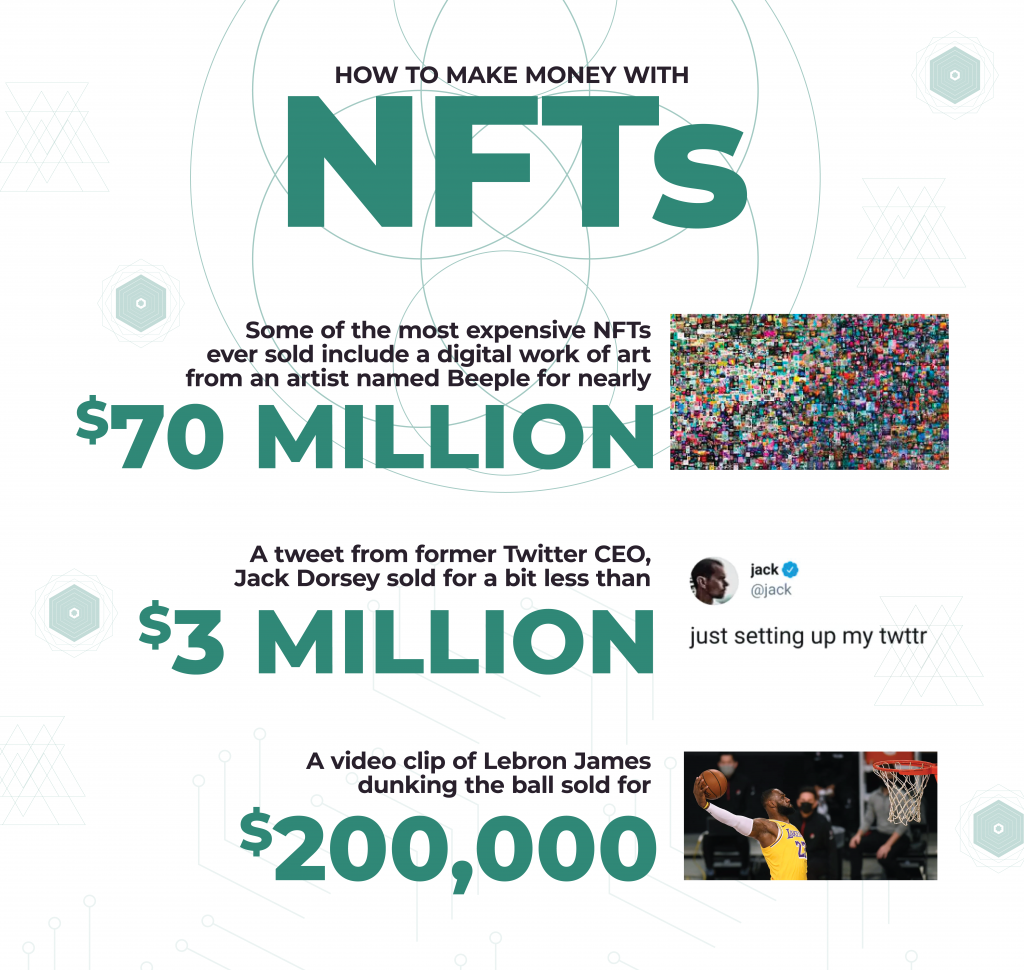
You’re not a tech guru or a startup entrepreneur. You are familiar with crypto, and maybe you’re already investing. Therefore, you have a basic understanding of blockchain technology. More than anything, you’re wondering what NFTs are, and what is the future of NFTs. You also wonder whether you too, can leverage them to make some passive income.
Some of the most expensive NFTs ever sold include:
- digital artwork from an artist named Beeple for nearly $70 million at Christie’s auction house
- a tweet from former Twitter CEO Jack Dorsey for a bit less than $3 million
- a video clip of Lebron James dunking the ball for $200,000
That’s a lot of money. We’re not there yet.
Virtual assets, such as in-game items, virtual real estate, and digital art, are also considered digital assets. These assets exist only in digital form, but can have real-world value and be bought, sold, and traded like physical assets.
The first step to getting there, though, is to understand what NFTs are and how they’re made:
- Non-fungible tokens (NFTs) are associated with bits of unique, digital property, linked to the blockchain. That’s the same technology ensuring your cryptocurrency like Bitcoin (BTC) and Ethereum are legit. Unlike crypto, though, which is fungible, NFTs are non-fungible. And no, that has nothing to do with mushrooms.
Think of it this way, cryptocurrency is a little bit like an actual coin or a dollar bill, representing some other kind of value. In the instance of a quarter or a fiver, value at the federal reserve: exchange one-dollar bill for another, and the value remains the same. Cryptocurrency, then, similarly represents value on the blockchain.
What an NFT accomplishes is assigning truly one-of-a-kind value to a digital asset, like a certificate or a statement of authenticity in the digital space, backed up by the blockchain. This way, in our copy-n-paste world, you know you really are the one — or at least among the very few — that own a work of NFT art, a historic bit of video, or even just a tweet.
- NFTs are created, or minted, by average, everyday users, just like you, on the Ethereum blockchain, among others. If you’re already using Ethereum, you’re halfway there. The vast majority of NFTs, though, are open source, meaning you can mint them on one platform, and display or sell them on another platform, like OpenSea, just for one example.
Once created, your NFT remains “in custody” in your crypto wallet. It’s then associated with a “collection.” These could be audio files, digital images, or even music files. Really, any kind of digital content. NFTs can be named, described, and even the rarity of the NFT is customizable.
Once the digital content associated with the NFT is put up for sale — Mintbase being a good platform for digital artists — the buyer can feel confident that what they’ve purchased is truly unique, a claim backed up by blockchain. You can certainly give away or trade your NFT for free, but this tokenization stays with the digital property, acting as a certificate of authenticity, similar to the antiques or collectibles market.
What is DeFi?
DeFi, short for Decentralized Finance, refers to a fast-growing ecosystem of financial applications and protocols built on decentralized blockchain networks. Unlike traditional finance, which relies on centralized institutions like banks and government agencies to manage financial activities, DeFi allows individuals to transact and access financial services directly, without intermediaries.
DeFi applications typically operate on open-source protocols, smart contracts, and decentralized networks. This means that anyone with an internet connection can access and participate in DeFi activities, regardless of their geographical location or financial status.
So far we’ve covered a bit about what NFTs are, how they’re made, why they work, and that there have been several high-profile NFT transactions recently, making headlines in the media. But you’re here to find out how you, too, can make money with NFTs or trading NFTs. Those answers are coming up in our next section.
Creating and Selling Your Own NFTs
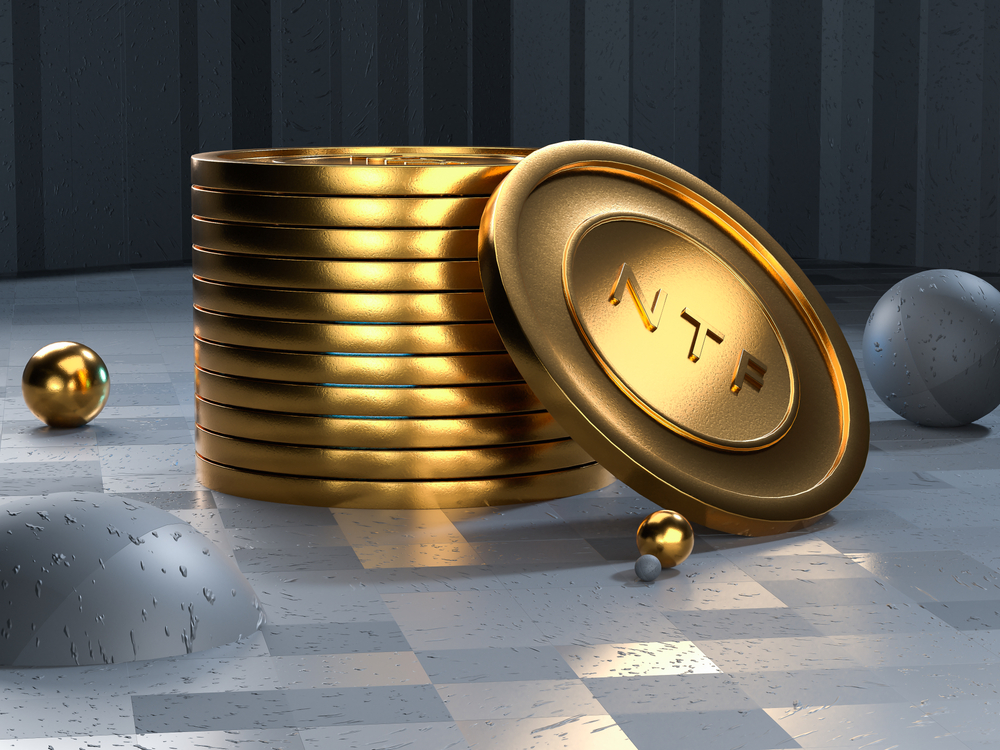
You can create and sell your own NFT. As explained, this can be for almost any kind of digital asset: music files, digital art, or just photo files. You are interested in making money or even flipping NFs. Here’s how you make money on NFTs.
1. Invest in crypto
The first thing you’re going to need to make and sell NFTs is to invest in some cryptocurrency. You can also trade NFTS. NFTs got their start on the Ethereum platform (Eth). There are some other NFT platforms available, but for the sake of our example, we’ll use Ethereum. You’re going to need some crypto because any platform you choose to make your NFT, including Eth, will charge you fees for the service, payable in — you guessed it — crypto.
In case you’re not familiar with the processing of buying crypto, here are the steps:
- Create a wallet. This step can be done through a variety of browser extensions, or wallet apps. Some of the most common are Coinbase Wallet or MetaMask. The process then requires nothing more than creating an account, which in the instance of a non-custodial wallet, typically requires very little personal information.
- Buy some crypto. Once you’ve created your wallet, the step in the process is to buy some crypto. Using Eth as our example, this process is generally quite easy — nothing more than pushing the “buy” from within the Ethereum interface. Crypto can be paid for in any number of ways, including Apple Pay, or even just your own personal debit card. Be warned, though, because the price of crypto, including ETH, can fluctuate wildly.
At this point, you’re pretty much done. The only remaining thing to do is keep track of the private key your crypto will have been assigned, and then transfer the crypto into your wallet. There are a few additional things to know and some potential variables in the process, but on a basic level, that’s all you need to know about investing in crypto in order to make and sell NFTs.
Now that you have some cryptocurrency to either pay to create your own or to purchase pre-existing NFTs, the next step is to choose an NFT marketplace.
2. What is an NFT Marketplace?
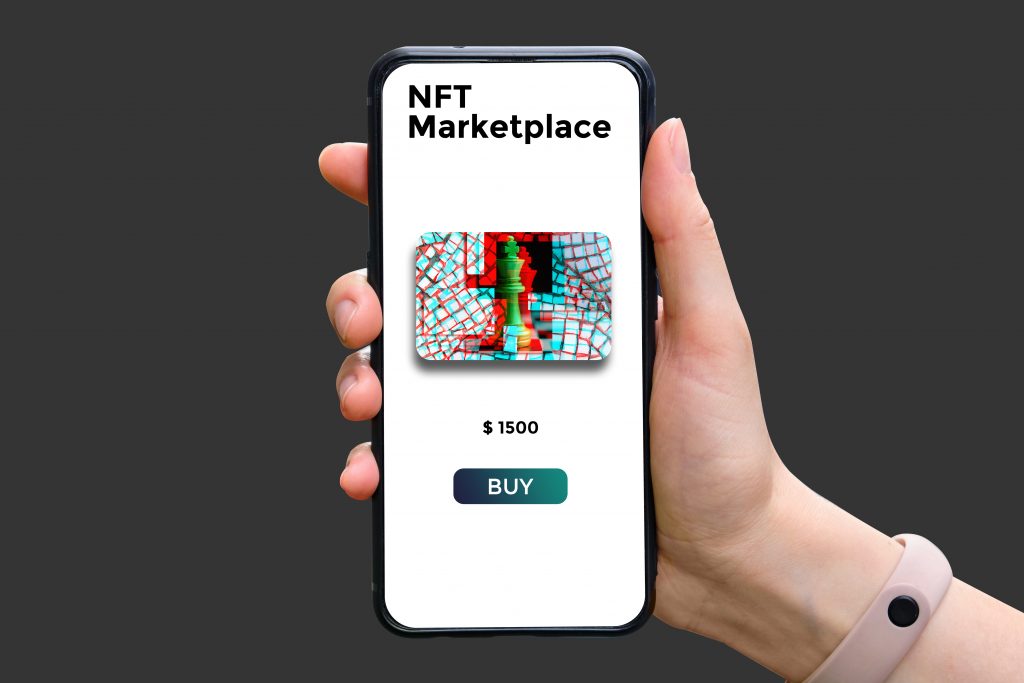
An NFT marketplace is nothing more than what it sounds like: an online place to virtually list your own NFT or to invest in someone else’s. Here are some of the most common, and many are free to join:
There are also video game-based marketplaces such as Axie Infinity Marketplace. This is an NFT game.
Once you’ve selected a crypto marketplace, the next step is to create a profile and to connect your Eth wallet by following the prompts in both the NFT marketplace you have chosen and your crypto platform of choice. With some minor differences, this process is much the same across all platforms and throughout the different marketplaces.
Now it’s time to create your NFT.
3. How to Create an NFT
As previously mentioned an NFT, or non-fungible token can be created and attached to almost any kind of digital asset. These can be listed on a marketplace such as:
- memes
- audio files
- cell phone video
- digital photographs
- digital trading cards
Just because it’s an NFT, however, it doesn’t mean your content will sell. Many marketplaces are full of NFTs that won’t make money.
Nevertheless, NFTs can dramatically improve the price of virtual property, acting something like a certificate of authenticity in the antiques and collectibles market. Sure, NFTs can be shared, traded, and given away for free, but that NFT ensures that, no matter what, this digital property is the one and only: the real deal.
With that out of the way, here’s a basic overview of how to create your own NFT, once you’ve invested in some crypto and settled upon the NFT marketplace, and linked your crypto wallet.
- Create a collection. The first step in the process of creating NFTs is to create a collection, typically under the “create” dropdown menu. From there, you’ll follow the prompts, supplying the requested information.
- Click on: new item. The next step is to upload your artwork, first by selecting “new item” in the create dropdown menu, and again, working through the prompts.
- Create. And with that, you’ve created your own NFT!
But just as anyone who has ever tried to bring a good or service to market knows: Just because you’ve created an NFT, it doesn’t mean it’s going to sell. There are a lot of factors affecting whether or not your item will make money, beginning with marketing. We’ll cover tips for marketing your collection in our next section.
4. How to Market an NFT
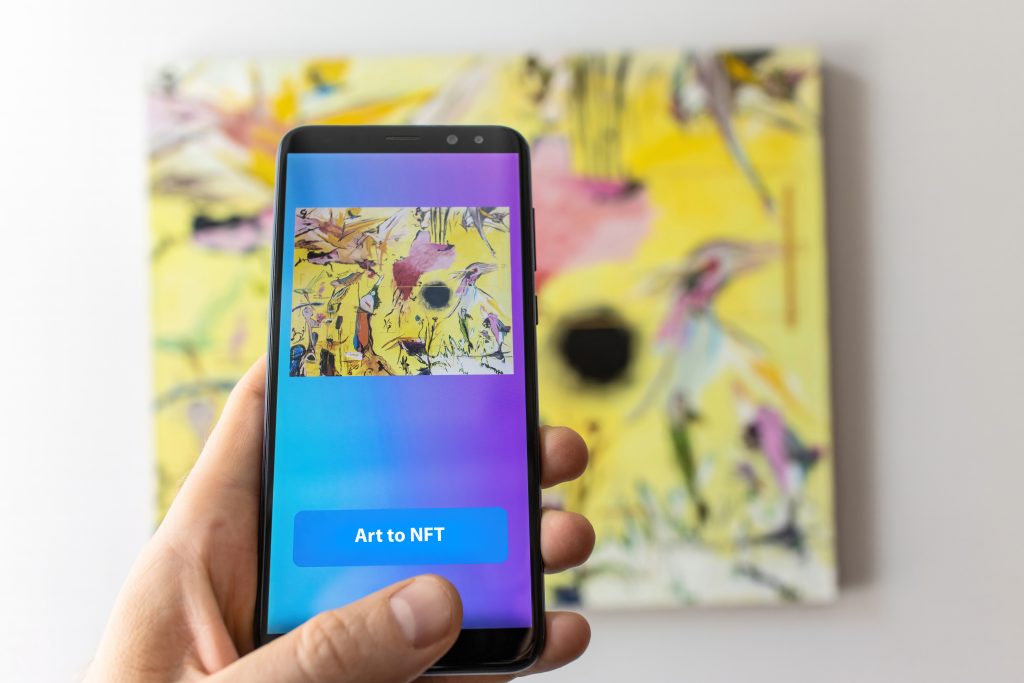
There are a few different ways to draw eyeballs to your NFT collection, some free, and others paid. Here are some suggestions:
- List it on the NFT Calendar. NFT Calendar is perhaps the best and only way to list your NFT across all the different NFT marketplaces in one, simple to use and easy to navigate interface. To use NFT calendar requires the following information:
- The title of your NFT collection or work of art and a detailed description.
- Information about the NFT creator
- Visuals, date, and time associated with your NFT drop
- The marketplace where your NFT will be listed and a link to the NFT
- Social media and Reddit. Building or utilizing social media channels or even creating a thread on Reddit or Bitcointalk are two additional ways to market your NFT. Remember, NFTs are still a relatively new concept so you may need to spend some time educating your followers about how NFTs work, as well as your particular collection.
- Word of mouth. Sometimes the best way to market an NFT is the most old-fashioned way to market any kind of product: through word of mouth, or by asking your friends, family and colleagues to join the effort, sharing your NFT on their own social media channels or in their own real-life social circles.
- Featured drops and marketplace newsletters. Depending on the marketplace you choose to host your NFT, chances are they have a featured drops page on their website, or perhaps even their own newsletter in which your drop could be publicized. The process to get your NFT listed in a newsletter or in the featured drops page varies, and most often there’s no guarantee your drop will make the cut. The step to find out, though, is to contact the marketplace or check the FAQ section. Doing so really can be worth it.
In addition to what we’ve already mentioned, there are some effective paid ways to market your NFT, including:
- paying an influencer to mention your drop
- hiring a PR agency
- marketing your drop in a themed social media account
If you already have your own website, be sure to promote your NFT there as well.
A note about pricing:
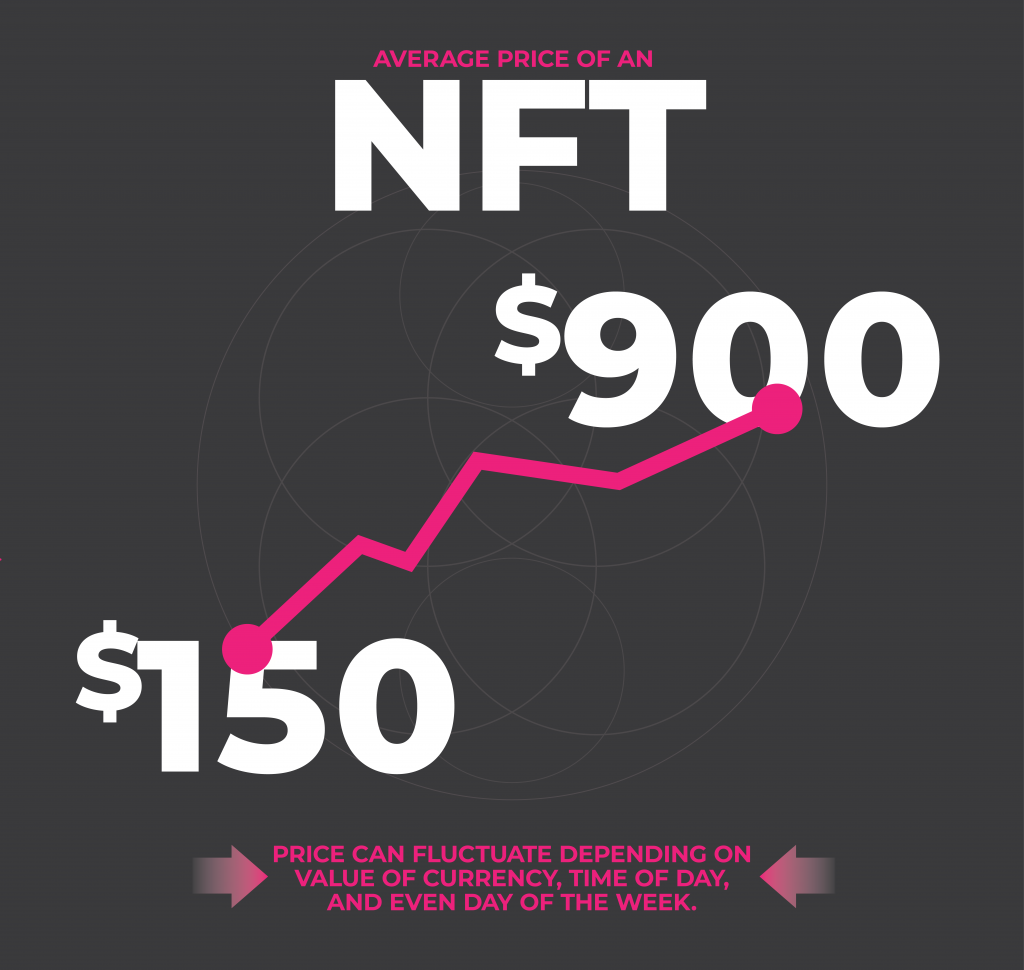
Yes, creating and marketing your NFT is important, but so far we’ve neglected to mention what many consider the most important question of all related to non-fungible tokens: How do I price my first NFT? What are NFT sales like? What are my chances of making money?
The average price of an NFT can vary, depending on the marketplace, anywhere from $150 to $900. Even then, those prices fluctuate depending on the value of the currency, the time of day, and even the day of the week.
Unfortunately, there’s no formula or blueprint for pricing an NFT, and this bit of the process can take a fair bit of trial and error. Making the question particularly tricky is the fact that the value of most cryptocurrencies fluctuates wildly. That being said, here are some things to consider when you’ve reached this step in the process of creating and selling your own NFT:
How do you price an NFT:
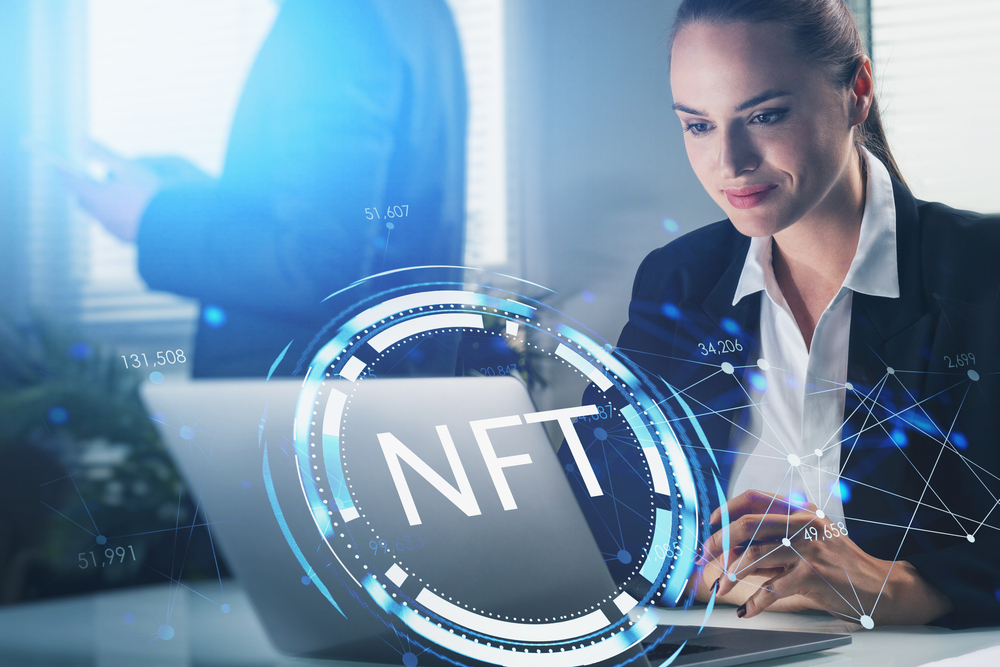
- Start low, but aim high. Pricing an NFT is like pricing any kind of artwork, seemingly impossible. For this reason, it’s generally best to enter the NFT marketplace — or really any other kind of marketplace, for that matter — with your product reasonably priced, and with the understanding that it can some time before you make a sale. That being said, track your progress and don’t be afraid to raise your price when and if things catch on.
- Be willing to experiment. Setting a floor and a ceiling, sharing your story whenever and wherever you can (oftentimes, when it comes to buying a work of art of any kind, a collector will buy based on an artist’s story just as much as they’re willing to pay for a particular work of art.) Some popular ways of experimenting with your NFT include what’s called gamification or unlockables, allowing the purchaser to make limited physical copies of the work to hang on their own wall, adding a print or t-shirt to sweeten the deal, or even some kind of discount code for future purchases.
It’s also helpful to understand that dollar amounts in the crypto space don’t necessarily equal real-world cash value. As in, you might find it unthinkable to price your art for thousands of dollars at a local art fair, but thousands of dollars in crypto like Eth is a very different thing, Especially when compared to what else is out there on the market, that might be a very reasonable price after all.
Like anything, making money with NFTs is not a surefire thing. So far we’ve covered what NFTs are, how they work, how to create them, how to price them, and how to market them. There are a few additional ways to invest in and make money on an NFT, which we’ll cover in our last section.
How to Invest in NFT
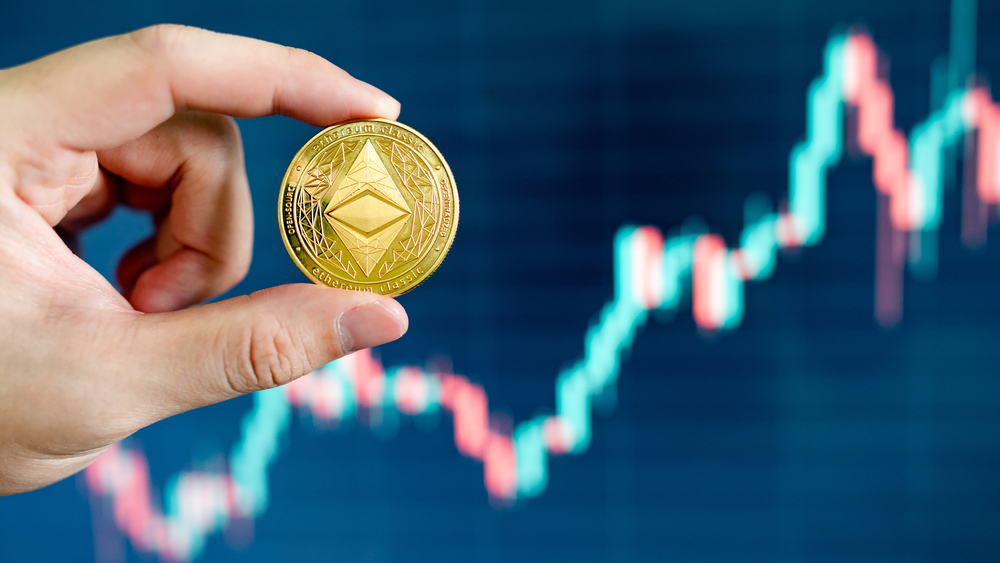
Maybe you’re not interested in mining your own NFT, but instead, you’re interested in buying and selling other people’s NFT for a profit, or hanging on to the digital asset until it increases in value, and then selling it. This is also possible, and initially, the process is much the same as it is to create an NFT of your own.
1. The first step is to purchase some Eth (the crypto most commonly accepted on NFT marketplaces) and send your crypto to your MetaMask wallet.
2. Connect your MetaMask to OpenSea. There are other NFT marketplaces to choose from, but what’s important is to find one with a secondary marketplace, allowing you to list your NFT when it’s time to sell. In addition to OpenSea, we recommend the following:
An advantage of Nifty Gateway is that it allows credit card transactions, and NBA Top Shot is a specialty market for buying and selling officially-licensed NBA collectibles. More than anything though, before getting into buying and selling NFTs for profit, it’s important to keep an eye on crypto values, which are highly volatile, proving that in the new frontier of non-fungible tokens, one adage style holds true: to make money on anything, it’s important to buy low and sell high.
You can also stake NFTs. NFT staking is when you lock your NFT projects and allow them to earn rewards without having to sell them. This does not apply to all NFTs. Staking NFTs is a way of storing digital assets. The rewards may be in the platform’s currency, or can even be traded for other currencies. They may have cash value.
How To Make Money With NFTs: Closing the Deal
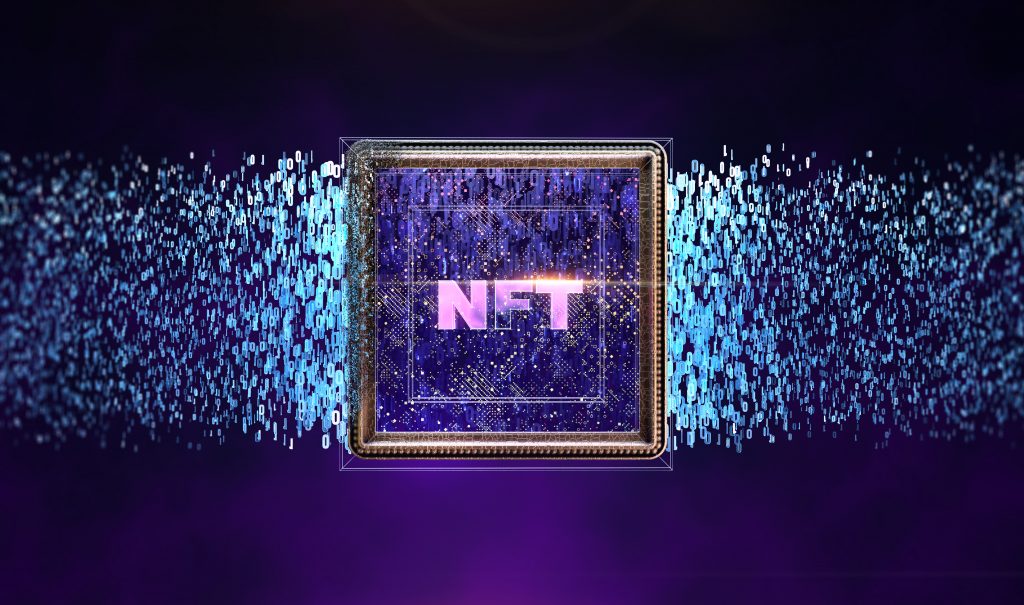
Cryptocurrency and NFTs, or non-fungible tokens, are defining the way business is done on the internet, opening up whole new worlds of possibility to buy and sell digital assets like:
- audio files
- piece of wart
- memes
- video clips with a virtual certificate of authenticity, backed up by the blockchain
In this guide, we present a basic overview of creating, marketing. and selling your own NFT, and even how to invest in other NFT to resell on secondary markets for a profit. With careful consideration and responsible planning, it is possible that you, too, can make money with NFTs. We hope this article helped you get started.
